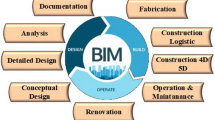Abstract
This paper describes an implementation process for a domain-specific computer programming language: the Building Environment Rule and Analysis (BERA) Language. As the growing area of Building Information Modeling (BIM), there has been a need to develop highly customized domain-specific languages for handling issues in building models in the architecture, engineering and construction (AEC) industry sector. The BERA Language, one of the domain-specific languages, deals with building information models in an intuitive way in order to ensure the quality of design and assess the design programming requirements using user-defined rules in the early design phases. To accomplish these goals, the BERA Language provides the capabilities for an effectiveness and ease of use without precise knowledge of general-purpose languages that are conventionally used in BIM software development. Furthermore, the design and implementation of the BERA Language focuses on building objects and their associated information-rich properties and relationships. This paper represents the implementation issues of the BERA Language associated with the building information models, their mapping into the building data structure, and their instantiation and execution. In addition, Portability of the language, extensibility and platform-dependent issues are involved in the BERA Language implementation. The implementation described in this paper is based on the use of Industry Foundation Classes (IFC) as given building information models, Solibri Model Checker\({\circledR }\) (SMC) as an IFC engine, and the Java Virtual Machine (JVM) as a compilation and execution environment.
Similar content being viewed by others
References
Eastman, C.M.: From blue print to database. Economist, Economist Technology Quarterly June 7, 18–22 (2008)
Sanguinetti, P., Abdelmohsen, S., Lee, J., Lee, J.-K., Sheward, H., Eastman, C.M.: General system architecture for BIM: An integrated approach for design and analysis. Adv. Eng. Inform. 26(2), 317–333 (2012)
Lee, J.-K., Lee, J., Jeong, Y.-s., Sheward, H., Sanguinetti, P., Abdelmohsen, S., Eastman, C.M.: Development of space database for automated building design review systems. Autom. Constr. 24(2012), 203–212 (2012)
Zhang, S., Teizer, J., Lee, J.-K., Eastman, C.M., Venugopal, M.: Building information modeling (BIM) and safety: Automatic safety checking of construction models and schedules. Autom. Constr. 29, 183–195 (2013)
Scott, M.L.: Programming Language Pragmatics, 2nd edn. Morgan Kaufmann Publishers (2005). ISBN 978-0126339512
ECMA International.: ECMA International. http://www.ecma-international.org/ (2010). Accessed Feb 2010
ECMA International.: Standard ECMA-262 - ECMAScript Language Specification. http://www.ecma-international.org/publications/files/ECMA-ST/ECMA-262.pdf (2010). Accessed Feb 2010
ISO 16262: ISO/IEC 16262:2002, Information technology - ECMAScript language specification. http://www.iso.org/iso/catalogue_detail.htm?csnumber=33835 (2010). Accessed Feb 2010
W3C: World Wide Web Consortium: W3C, an international community where member organizations, a full-time staff, and the public work together to develop Web standards. Led by Web inventor Tim Berners-Lee and CEO Jeffrey Jaffe. http://www.w3.org/ (2010). Accessed Nov 2010
W3C: W3C Cascading Style Sheets (CSS). http://www.w3.org/TR/CSS1/ (2010). Accessed Feb 2010
Web2.0: Web 2.0 by Paul Graham: Does Web 2.0 mean anything? http://www.paulgraham.com/web20.html (2010). Accessed Nov 2010
W3C: Extensible Hyper Text Markup Language 2 (XHTML2) Working Group Home Page, also contains old standards for HTML4, XHTML1.0, etc. http://www.w3.org/MarkUp/ (2010). Accessed Nov 2010
XHTML: Extensible Hyper Text Markup Language (XHTML) Reference. http://xhtml.com/en/xhtml/reference/ (2010). Accessed Nov 2010
W3C: Extensible Markup Language: XML. http://www.w3.org/XML/ (2010). Accessed Nov 2010
W3C: Scripting and AJAX. http://www.w3.org/standards/webdesign/script.html (2010). Accessed Nov 2010
JQuery: jQuery Project, a fast and concise JavaScript Library that simplifies HTML document traversing, event handling, animating, and Ajax interactions for rapid web development. http://jquery.org/ (2010). Accessed Nov 2010
Netscape Communications: The Netscape Archive. http://browser.netscape.com/ (2010). Accessed Feb 2010
W3C: W3C Document Object Model (DOM). http://www.w3.org/DOM/ (2010). Accessed Feb 2010
Lethbridge, T.C., Laganiere, R.: Object-oriented Software Engineering. McGraw-Hill (2005). ISBN 978-0073220345
Gay, J.: The History of Flash, Macromedia Showcase, Jonathan Gay, 2001. http://www.adobe.com/macromedia/events/john_gay/page02.html (2010). Accessed Feb 2010
ActionScript: Adobe Inc., Action Script, a scripting language based on ECMA script for controlling Adobe Flash Media (FLA/SWF files). http://www.actionscript.org/ (2010). Accessed Feb 2010
W3C: W3C Cascading Style Sheets (CSS). http://www.w3.org/TR/CSS1/ (2010). Accessed Feb 2010
The Open Group: Regular Expressions, The Single UNIX Specification, Version 2, 1997. http://www.opengroup.org/onlinepubs/007908799/xbd/re.html (2010). Accessed Feb 2010
Mashey, J.R.: New programming languages are born every day. Why do some succeed and some fail? ACM Queue Volume 2, Issue 9 (December/January 2004-2005) - Languages, Levels, Libraries, and Longevity (2004)
Parr, T.: The Definitive ANTLR Reference: Building Domain-Specific Languages, Pragmatic Bookshelf (2008). ISBN: 978-0978739256
Lee, J.-K., Eastman, C.M.: Building Environment Rule and Analysis (BERA) Language, Under Review (2014)
Lee, J.-K., Eastman, C.M., Lee, Y.C.: Design Review Applications for the Spatial Program and Building Circulation using BERA Language, Under Review (2014)
Scott, M.L.: Programming Language Pragmatics, 2nd edn. Morgan Kaufmann Publishers (2005). ISBN 978-0126339512
Parr, T.: Language Implementation Patterns: Create Your Own Domain-Specific and General Programming Languages, Pragmatic Bookshelf (2009). ISBN: 978-1934356456
Parr, T.: ANTLR, Another tool for language recognition, http://www.antlr.org. Accessed Feb 2010
Parr, T.: StringTemplate, www.stringtemplate.org. Accessed Feb 2010
Parr, T.: Soapbox: Humans should not have to grok XML - Answers to the question When shouldn’t you use XML? IBM developerWorks, Terence Parr, (2001), http://www.ibm.com/developerworks/xml/library/x-sbxml.html Accessed Feb 2010
Dijkstra, E.W.: On the role of scientific thought. In: Dijkstra, E.W. (ed.) Selected Writings on Computing: A Personal Perspective, pp. 60–66. Springer-Verlag New York, Inc., New York (1982). ISBN 0-387-90652-5
MDA.: Model driven architecture (MDA), OMG Architecture Board ORMSC, OMG document number ormsc/2001-07-01 (2001)
Kent, S.: Model Driven Engineering, Integrated Formal Methods. Lect. Notes Comput. Sci. 2335/2002, 286–298 (2002). doi:10.1007/3-540-47884-1_16
Author information
Authors and Affiliations
Corresponding author
Rights and permissions
About this article
Cite this article
Lee, JK., Eastman, C.M. & Lee, Y.C. Implementation of a BIM Domain-specific Language for the Building Environment Rule and Analysis. J Intell Robot Syst 79, 507–522 (2015). https://doi.org/10.1007/s10846-014-0117-7
Received:
Accepted:
Published:
Issue Date:
DOI: https://doi.org/10.1007/s10846-014-0117-7




